This essay has been prompted by comments I made to Barney Sandeman that I can sail my Sydney-based classic Nicholson 60, HURRICA V single-handed, and I repeat here that I am confident I could, on my own, sail the 1,200 miles from Australia to New Zealand. That said, HURRICA V was planned as a short-handed family cruising vessel capable of crossing oceans, and, while far from the same, I have regularly sailed alone the 30-mile leg to our favourite cruising grounds where I go early to get a good anchorage before the family arrive later. But first some background information…
Background
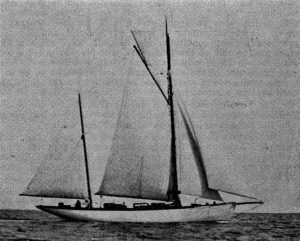 HURRICA’s original sheep station-based owner, appearing immune to cost, owned three yachts including his 55ft racer, and retained a nucleus of three full-time crew. By 1927 he had had the gaff mizzen converted, and in 1941 the next owner stood a new bermudan rig.
HURRICA’s original sheep station-based owner, appearing immune to cost, owned three yachts including his 55ft racer, and retained a nucleus of three full-time crew. By 1927 he had had the gaff mizzen converted, and in 1941 the next owner stood a new bermudan rig.
Enter me, Steve Gunns, in 2002, owner and skipper of HURRICA V, the soon-to-be-restored classic for which I became designer and project manager. Tending to be a little hyper, and with skills as an architect and builder, along with experience in deck layout and top level yacht racing, I still thought, “where do I start?”
The primary, but far from the only, decisions in my restoration plan were what amendments might be needed to Nicholson’s sail plan to improve sailability and living aboard. I wanted a usable family yacht to sail with my wife Annabel and our young boys, without crew. But our vessel had to look good and portray the spirit of the 1920s, if not as an exact reproduction. I could hardly see Annabel enjoying a day out with friends on the harbour when I suggested that we hoist our gaff ketch main followed by the jack-yard topsail – I would need to learn to swim! I daren’t even think about it if we had a cutter’s 40ft boom.
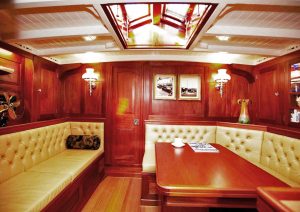 I researched the Camper & Nicholson records at Greenwich, UK, in which HURRICA V of 1922 is noted as Yard No 315. A short trawl through the archive to Yard No 318 and I had my answer. Designed just three months later, BARBARA was a 48ft bermudan yawl retaining a long and low sail profile with triple headsails on a HURRICA-length bowsprit. This was to be our template, and, being designed within months of HURRICA’s design, BARBARA’s sail plan could easily have been intended for us.
I researched the Camper & Nicholson records at Greenwich, UK, in which HURRICA V of 1922 is noted as Yard No 315. A short trawl through the archive to Yard No 318 and I had my answer. Designed just three months later, BARBARA was a 48ft bermudan yawl retaining a long and low sail profile with triple headsails on a HURRICA-length bowsprit. This was to be our template, and, being designed within months of HURRICA’s design, BARBARA’s sail plan could easily have been intended for us.
Sails and Sailing
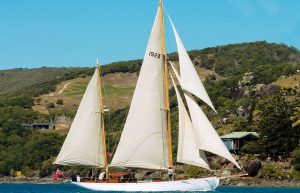 HURRICA’s new sail plan features a five sail wardrobe, meaning that each of the three headsails is tiny, making handling easy. As wind increases the headsails are dropped from the front to rear; at 15 knots the jibtop is lowered first and lashed, then the jib and staysail are furled as wind increases. Different sail combinations work in heavy wind depending upon the wind angle and sea state, but too much wind generally loads up the mizzen creating excessive weather helm, so this can often be the first sail lowered.
HURRICA’s new sail plan features a five sail wardrobe, meaning that each of the three headsails is tiny, making handling easy. As wind increases the headsails are dropped from the front to rear; at 15 knots the jibtop is lowered first and lashed, then the jib and staysail are furled as wind increases. Different sail combinations work in heavy wind depending upon the wind angle and sea state, but too much wind generally loads up the mizzen creating excessive weather helm, so this can often be the first sail lowered.
However, a small idiosyncrasy now comes in. Neither the crew on the sheet, nor the helmsman can see the jib and jibtop as they are concealed behind the staysail. Crew can be sent forward to call the sheeting, but it is easier, especially short-handed, to mark the sheet so the sail can be positioned reasonably accurately without going forward.
Runners
The runners were originally tensioned by rope and tackle (but I had no intention of reverting to the use of tackle). All options for winches were tested and the winch handle arc proved remarkably space-devouring. Although I had been warned against Highfield levers, they became the next possibility. Highfield levers with a narrow fixed platform solved the problem but had to be custom-made – the natural bronze does enhance the historic impact.
Nicholson had the runner levers designed at such a wide angle at the maximum beam amidships, that the boom can tack effectively with both runners simultaneously engaged. The mizzen is similarly set at the maximum available beam, and the warnings against having runners have proven baseless.
No Vangs
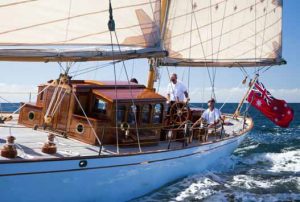 HURRICA has no vang. Without a boom vang and with sheets eased, the aft end of the boom lifts, while HURRICA’s boom length has been carefully designed so that as this happens, it clears the mainmast backstays and the mizzen mast forward lowers. During a tack, but especially a gybe, the lifting boom end allows the leech to open and subsequently eases pressure on the sail. Once the main is set on the new tack, it is still open-leeched until sheeting re-applies the pressure. This is effectively a de-powering mechanism that makes gybing easy even in heavy weather – more later!
HURRICA has no vang. Without a boom vang and with sheets eased, the aft end of the boom lifts, while HURRICA’s boom length has been carefully designed so that as this happens, it clears the mainmast backstays and the mizzen mast forward lowers. During a tack, but especially a gybe, the lifting boom end allows the leech to open and subsequently eases pressure on the sail. Once the main is set on the new tack, it is still open-leeched until sheeting re-applies the pressure. This is effectively a de-powering mechanism that makes gybing easy even in heavy weather – more later!
To save potential damage to the coachroof if a halyard is dropped inadvertently, permanently lashed topping lifts support both booms.
Rigging
Instead of hemp ropes and wire, HURRICA now has comfortable Dynex Dux high strength boom strops with the exposed grey core appearing as wire unless examined really closely. Where the cores are not exposed, all ropes have white casings that cause minimal abrasion – they’re kind to hands and are gentle against the varnished booms. The virtually stretchless Dyneema halyards require little or no adjustment during a day’s sail. Halyard tails travel to their winches via jammers, making sail hoisting controllable and easy. The visual effect of jammers is definitely un-classic, but the black finish has been diluted by a covering of an exterior film the same colour as the Douglas fir masts.
Winches
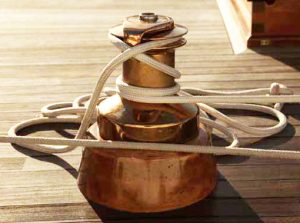 The main and mizzen sheet cockpit winches are both adjacent the helm for safety, and both horses (travellers) are clear of the cockpit for comfort (unlike the original layout had the main horse across the front of the cockpit). All headsails and the mainsail are hoisted on discrete electric Andersen winches on the side of the mast, while the headsails sheet to over-sized bronze deck-mounted.
The main and mizzen sheet cockpit winches are both adjacent the helm for safety, and both horses (travellers) are clear of the cockpit for comfort (unlike the original layout had the main horse across the front of the cockpit). All headsails and the mainsail are hoisted on discrete electric Andersen winches on the side of the mast, while the headsails sheet to over-sized bronze deck-mounted.
With a wide, flush, mast-to-mast working platform, and self-tailing winches, it is possible for a single crewmember to cover the entire sector between the masts, greatly reducing the number of crew required.
Hull, Keel and Motion
HURRICA has a classic but beamy hull form with shallow draft and heavy displacement. The high level of form stability and powerful hull results in a stiff and stable yacht. These characteristics provide a gentle, loping motion at sea and, assissted by high bulwarks, a confident crew can work securely without fear of being pitched overboard.
The 40ft long keel allows a true course to be held even in rough and quartering seas but, while the long keel holds course, this makes tacking and gybing quite slow. The slowness to change direction could at first appear a distraction, however that slowness becomes a friend as it allows a leisurely tack giving the crew with more time to function.
Steering
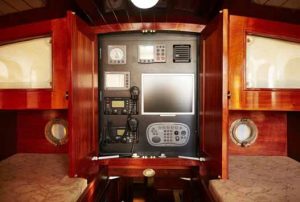 The 1920s aft-facing reverse-style steering can appear confusing and illogical, but is very effective and not difficult to master. HURRICA is never steered with the helmsman forward of the wheel, but is steered from sitting behind the wheel on either side of the steering box. The further outboard he is, the better the helmsman can see both the sails and the sea ahead, as, on the centreline, a the mizzen obscures the line of sight. We find the vessel is more often than not sailed on the autopilot on electronic charts and, if necessary, steering is available away from the cockpit by remote control.
The 1920s aft-facing reverse-style steering can appear confusing and illogical, but is very effective and not difficult to master. HURRICA is never steered with the helmsman forward of the wheel, but is steered from sitting behind the wheel on either side of the steering box. The further outboard he is, the better the helmsman can see both the sails and the sea ahead, as, on the centreline, a the mizzen obscures the line of sight. We find the vessel is more often than not sailed on the autopilot on electronic charts and, if necessary, steering is available away from the cockpit by remote control.
An extremely un-classic bow-thruster has been fitted. I spoke to many parties about this inclusion and concluded that a die-hard would be disgusted, but any owner wanting a friendly usable yacht would welcome it, especially being below the waterline where it remains out of sight. Reversing any classic can be a fearful experience, and exiting my berth was always a concern. I now drive onto a forward springer if necessary to give some angle out, plod backwards with the helm fixed onto the centreline and push the nose to port or starboard with the thruster to steer. It takes a little getting used to but once mastered reversing is no longer an issue.
Sailing HURRICA
 Day sailing on any classic, if properly planned around course, current and wind direction, is unlikely to involve many tacks or gybes, especially in high winds – because then, surely, you would stay in port. With a reaching course planned for the day, even fewer tacks or gybes would be needed. It took a while to master the manoeuvres, but the following is the benefit of my experiences.
Day sailing on any classic, if properly planned around course, current and wind direction, is unlikely to involve many tacks or gybes, especially in high winds – because then, surely, you would stay in port. With a reaching course planned for the day, even fewer tacks or gybes would be needed. It took a while to master the manoeuvres, but the following is the benefit of my experiences.
At the berth, hank on the jib topsail and lash it to the bowsprit netting. Remove boom crutches to under-cockpit storage; boom weight is now taken on the permanent topping lifts. It is time to reverse steer from the berth with control provided by the bow-thruster.
Whichever will be the windward runners, are tensioned while the leeward runners are loosened to open the hoisting slot. One at a time, headsails are unfurled, halyards tensioned, sails sheeted and the helm eased away. You are now sailing.
Tacking
If necessary, steer slightly higher into the wind or haul in the main a little to allow the leeward runner to be tensioned with a quick flip of the Highfield.
Pre-tack
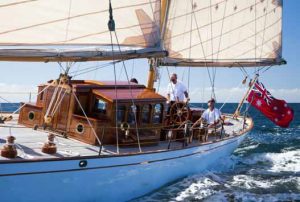 HURRICA’s sails can be heaved out of line while the keel comfortably retains course, (unlike a modern fin-keeled yacht). So the headsails – with no overlap – can be hauled hard on the windward sheet with the clews tending into the wind. A tacking angle of about 80 degrees, (while not particularly effective going into the wind), allows the crew those few extra seconds to prepare. When it is time to take up on the new sheets, there is nominal drag, the sails are in control, and headsails can be hauled very close in (and sometimes fully sheeted without resorting to the winch) before the tack is complete. If uncomfortable, furl the jib and even the staysail so the jibtop is the only sail left to tack. Main and mizzen will look after themselves on the horses.
HURRICA’s sails can be heaved out of line while the keel comfortably retains course, (unlike a modern fin-keeled yacht). So the headsails – with no overlap – can be hauled hard on the windward sheet with the clews tending into the wind. A tacking angle of about 80 degrees, (while not particularly effective going into the wind), allows the crew those few extra seconds to prepare. When it is time to take up on the new sheets, there is nominal drag, the sails are in control, and headsails can be hauled very close in (and sometimes fully sheeted without resorting to the winch) before the tack is complete. If uncomfortable, furl the jib and even the staysail so the jibtop is the only sail left to tack. Main and mizzen will look after themselves on the horses.
Slowly at first, the steering of the tack will accelerate and experience is needed to under-correct as the tacking momentum will otherwise carry into a reach on the new leg if not careful. But the option of a free pair of hands can be available by setting the autopilot to a time and angle tack mode. When settled, the headsails are finish-trimmed and you are climbing to windward. You’ve tacked with no damage done.
Gybing
Gybing has a scare factor that has proved to be over-rated. When gybing in strong winds, the course is easily held under autopilot, while the main is power-winched to the centreline. HURRICA will hold course easily and, once the main is centred, all pressure goes off. The ability to hold a course greatly eases pressure on the crew and the tracking ability turns what could be a scary gybe into a comfortable sailing operation. On a recent trip downwind with full main and jib in the black of night, the breeze built very quickly to 30 knots apparent and caught us out. We obviously needed to reduce canvas urgently, but the thought of heading back to windward into thumping seas to lower the main was not exciting. So, downwind in a near gale, with three at the mast, we “simply” centred the main and heaved the halyard using the flogging to help it loose off the shrouds. Once gybed, the reefing line was taken in as the sheet was eased. I could not believe it worked and congratulated the crew, but congratulations should also go to the yacht: its level work area around the mast, its tracking ability and the powerful systems making such a manoeuvre possible. HURRICA can hold her mast high.
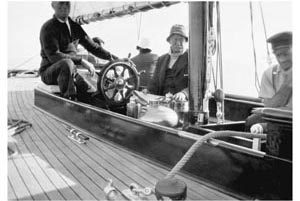 Three competent crew could easily handle HURRICA in any weather, on any course, while we have met our target to be a family yacht well capable of sailing two-handed in a moderate breeze.
Three competent crew could easily handle HURRICA in any weather, on any course, while we have met our target to be a family yacht well capable of sailing two-handed in a moderate breeze.
Now, if you want the best ride of your life, try sailing to windward. HURRICA is not particularly effective upwind, but effective or not, sailing to windward in 20 knots on a thundering and powerful classic gives a mind-blowing sensation of power. You won’t forget it.
PS. With the classics skills I have on hand, it would be a shame not to impart them to others, so I am available to consult on your design or help sail your classic.

